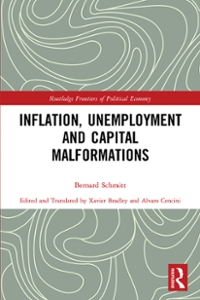Question
3. Understanding unemployment rates Phelps was suspicious of the tradeoff suggested by the Phillips curve. He thought that sensible, forward-looking people should not change their
3. Understanding unemployment rates
Phelps was suspicious of the tradeoff suggested by the Phillips curve. He thought that sensible, forward-looking people should not change their behavior just because the prices on all the price tags in the economy increased at 4% per year instead of at 2% per year.
Phelps started his analysis by asking what determines the unemployment rate. One of the key points he recognized was that unemployment is the inevitable consequence of an economy in which some firms go out of business each month and some workers quit their jobs each month. Once a worker is out of a job, the individual will take some time searching for the next one.
Consider the following scenario.
Picture an economy with 100,000 workers in its labor force. The unemployment rate is simply the number of unemployed workers divided by the number of workers in the labor force. At the beginning of January, the unemployment rate is 4.76%, so 4,760 people in the labor force are unemployed.
Suppose that in January, 15% of the workers who were unemployed at the beginning of the month start new jobs. This means that _________ people leave the unemployment category in January.
Suppose that in January the job separation rate equals 2%. That is, 2% of the people who were employed at the beginning of the month are laid off or quit. This means___________ people are added to the unemployment category that month. (Hint: Round your answer to the nearest whole number.)
Assume the size of the labor force does not change from January to February. Considering that the job separation rate is 2% during January, and 15% of unemployed workers find new jobs, the unemployment rate at the beginning of February will be approximately ______________.(Hint: Round your answer to the nearest hundredth.)
Generalizing from your calculations for January, if in February, the job separation rate is 2%, and 15% of unemployed workers get jobs, the unemployment rate at the end of February will ____________.
Suppose that at the beginning of August, the unemployment rate is 4.76%, however, this month just 0.2% of the employed workers become unemployed.
Suppose that in August, 15% of the workers who were unemployed at the beginning of the month find new jobs. The unemployment rate is at the beginning of September will be_________. (Hint: Round your answer to two decimal places.)
Now suppose that in September, the job separation rate returns to normal: 2% of the workers who were employed at the beginning of the month become unemployed. As always, 15% of the workers who are unemployed find jobs during the month.
In the last question, you calculated a lower unemployment rate for the beginning of September. Use the numbers of employed workers and unemployed workers implied by this unemployment rate to calculate how many employed workers become unemployed during September and how many unemployed workers find jobs during September.
The unemployment rate at the end of September is_________ .
Step by Step Solution
There are 3 Steps involved in it
Step: 1

Get Instant Access to Expert-Tailored Solutions
See step-by-step solutions with expert insights and AI powered tools for academic success
Step: 2

Step: 3

Ace Your Homework with AI
Get the answers you need in no time with our AI-driven, step-by-step assistance
Get Started


